This Complete List of Chicken Breeds with Pictures PDF offers a detailed guide to over 100 breeds‚ including their characteristics‚ egg-laying abilities‚ and visual identification features.
Chicken breeds vary widely in size‚ purpose‚ and appearance‚ making them a fascinating subject for poultry enthusiasts. With over 100 recognized breeds‚ each offers unique traits tailored to egg production‚ meat‚ or ornamental purposes. This guide provides a comprehensive overview‚ exploring their origins‚ characteristics‚ and uses. Whether for backyard farming or exhibitions‚ understanding these breeds helps in making informed decisions. The diversity in feather patterns‚ egg colors‚ and temperaments showcases the rich genetic variety within domestic chickens.
Classification of Chicken Breeds
Chicken breeds are classified based on their purpose‚ size‚ and origin‚ offering a structured way to understand their diversity. By purpose‚ they are categorized into egg-laying‚ meat production‚ or dual-purpose breeds. Size-wise‚ they range from large fowl to bantam varieties. Origin-based classification includes American‚ Mediterranean‚ and Asiatic breeds‚ reflecting their historical development. This system helps poultry enthusiasts and farmers select breeds tailored to specific needs‚ whether for productivity‚ companionship‚ or exhibition.
2.1. By Purpose (Egg-Laying‚ Meat Production‚ Dual-Purpose)
Chicken breeds are categorized by their primary purpose: egg-laying‚ meat production‚ or dual-purpose. Egg-laying breeds‚ like Leghorns‚ are bred for high egg production‚ while meat breeds‚ such as Cornish Cross‚ are selected for rapid growth and muscle development. Dual-purpose breeds‚ including Plymouth Rock and Australorp‚ balance egg production and meat quality. This classification helps poultry keepers choose breeds that align with their goals‚ whether for eggs‚ meat‚ or a combination of both‚ ensuring efficient and productive flock management.
2.2. By Size (Large Fowl‚ Bantam)
Chicken breeds are classified by size into Large Fowl and Bantam. Large Fowl‚ such as Plymouth Rock and Australorp‚ are full-sized birds known for their egg-laying and meat production. Bantams‚ like Silkies and Polish‚ are smaller‚ often kept as ornamental or pet birds. While Bantams are not as productive‚ they are popular for their compact size and unique appearances. This size-based classification helps enthusiasts choose breeds that suit their space‚ preferences‚ and backyard poultry-keeping goals effectively.
2.3. By Origin (American‚ Mediterranean‚ Asiatic)
Chicken breeds can be categorized by their origin into American‚ Mediterranean‚ and Asiatic groups. American breeds‚ such as Plymouth Rock and Rhode Island Red‚ are known for their hardiness and egg-laying abilities. Mediterranean breeds‚ like Leghorn‚ thrive in warmer climates and are highly productive. Asiatic breeds‚ including Brahmas and Cochin‚ are larger and often kept for their unique feathering and gentle nature. This classification highlights the diverse adaptability and traits of breeds from different regions.
Popular Chicken Breeds
Discover the most well-known chicken breeds‚ each with unique traits. Leghorn and Rhode Island Red are famous for high egg production‚ while Plymouth Rock and Australorp excel as dual-purpose birds. Araucana and Silkie captivate with their exotic features‚ such as blue eggs and fluffy plumage. These breeds are widely kept for eggs‚ meat‚ or as ornamental birds. The guide provides stunning images and detailed descriptions to help identify and choose the perfect breed for your needs.
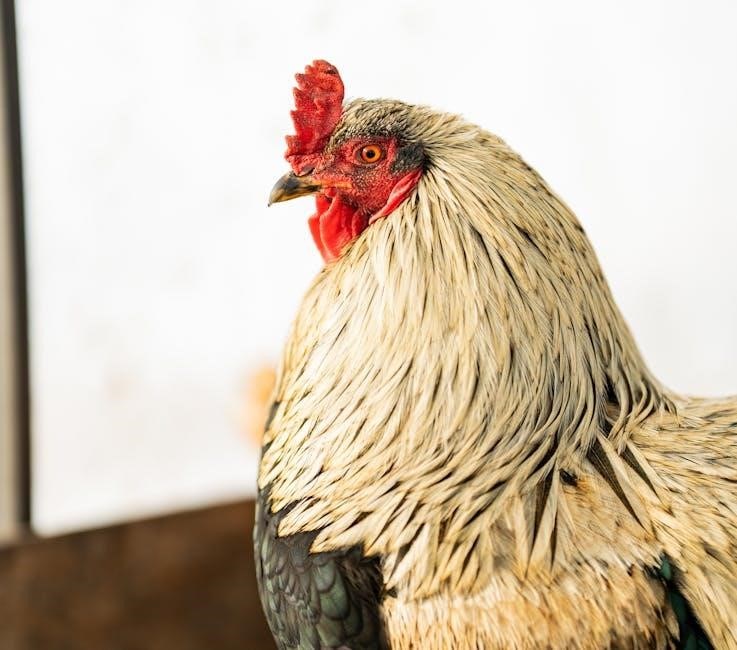
3.1. Heavy Egg Producers (Leghorn‚ Rhode Island Red)
Leghorn and Rhode Island Red are renowned for their exceptional egg-laying abilities. Leghorns produce up to 280-300 white eggs annually‚ while Rhode Island Reds yield 200-220 brown eggs. Both breeds are friendly‚ adaptable‚ and thrive in confined spaces. Their high productivity and hardiness make them ideal for backyard flocks. The guide includes vivid images and detailed egg characteristics‚ helping enthusiasts identify and select these prolific layers for maximum egg production.
3.2. Dual-Purpose Breeds (Plymouth Rock‚ Australorp)
Plymouth Rock and Australorp are popular dual-purpose breeds‚ excelling in both egg production and meat. Plymouth Rock‚ or Barred Rock‚ lays 200-280 brown eggs annually and is known for its friendly‚ hardy nature. Australorps are calm‚ with hens producing 200-250 brown eggs yearly. Both breeds adapt well to various environments‚ making them ideal for backyard flocks. The guide features photos and details on their temperament and productivity‚ helping owners choose the best dual-purpose chickens for their needs.
3.3. Exotic and Ornamental Breeds (Araucana‚ Silkie)
Araucana and Silkie are standout exotic breeds. Araucana is famous for laying blue or green eggs and has a calm‚ adaptable nature. Silkies‚ with their fluffy plumage‚ are often kept for their ornamental value and gentle temperament. Both breeds add unique charm to any flock. The guide includes vivid images and details on their care and characteristics‚ making them a favorite among poultry enthusiasts seeking distinctive and visually striking chickens.
3.4. Game Breeds (Cubalaya‚ Modern Game)
Game breeds like Cubalaya and Modern Game are known for their striking appearance and robust nature. Cubalaya‚ originating from Cuba‚ is celebrated for its vibrant plumage and fighting spirit. Modern Game‚ with its tall posture‚ is often kept for show due to its stunning looks. These breeds are generally more aggressive and require experienced handling. The guide provides detailed images and insights into their history‚ temperament‚ and care‚ making them a favorite among enthusiasts of traditional poultry breeds.
Characteristics of Chicken Breeds
Chicken breeds exhibit diverse characteristics‚ including physical traits like feather patterns‚ size‚ and color‚ as well as egg-laying abilities and temperament. Some breeds‚ such as Leghorns‚ are prolific egg layers‚ while others‚ like Silkies‚ are known for their docile nature. Physical features vary widely‚ from the striking plumage of game breeds to the compact build of bantams; Understanding these traits helps in selecting breeds suited to specific needs‚ whether for egg production‚ meat‚ or companionship;
4.1. Physical Traits (Feather Patterns‚ Size‚ Color)
Chicken breeds display a wide variety of physical traits‚ including feather patterns‚ size‚ and color. Feather patterns range from smooth to fluffy‚ while sizes vary from small bantams to large fowl. Plumage colors include white‚ black‚ brown‚ and even blue or green in some exotic breeds. These traits not only enhance visual appeal but also play a role in adaptability to different environments. Understanding these physical characteristics aids in identifying breeds and selecting those suited to specific needs or preferences.
4.2. Egg-Laying Abilities (Egg Color‚ Size‚ Frequency)
Egg-laying abilities vary significantly among chicken breeds‚ with differences in egg color‚ size‚ and frequency. Breeds like Leghorns are renowned for high egg production‚ laying large white eggs frequently. Others‚ such as Orpingtons and Australorps‚ produce brown eggs‚ with sizes ranging from small to extra-large. Some breeds‚ like Ameraucanas‚ lay unique blue or green eggs. Egg production frequency also differs‚ with Leghorns laying nearly daily‚ while others may lay less often. This diversity helps poultry keepers choose breeds that meet their egg production needs.
4.3. Temperament and Behavior (Friendly‚ Aggressive‚ Docile)
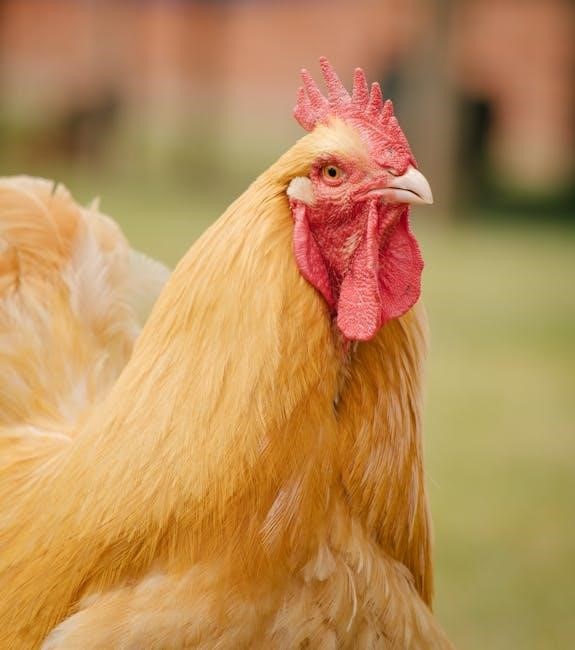
Chicken breeds exhibit a wide range of temperaments‚ from friendly and docile to aggressive. Breeds like Silkies are known for their calm‚ affectionate nature‚ making them ideal for backyard flocks. Others‚ such as Cubalaya and Modern Game‚ are more aggressive and suited for experienced keepers. Understanding a breed’s temperament is crucial for ensuring compatibility with your environment and management style. This section highlights key behavioral traits to help you select the perfect breed for your needs.
Visual Guide to Chicken Breeds
This section provides a comprehensive visual guide to chicken breeds‚ featuring high-quality images and detailed descriptions. Compare breeds side by side using comparison charts that highlight size‚ feather patterns‚ and egg-laying abilities. From the striking plumage of Araucanas to the sturdy build of Plymouth Rocks‚ this guide helps identify and distinguish between popular and rare breeds. Perfect for enthusiasts and newcomers alike‚ it offers a clear and engaging way to explore the diversity of chicken breeds.
5.1. High-Quality Images for Identification
The PDF features high-quality images of chicken breeds‚ showcasing their unique characteristics. From the blue eggs of Araucanas to the fluffy Silkie‚ each image aids in easy identification. Detailed visuals highlight feather patterns‚ sizes‚ and egg colors‚ making it a valuable resource for breeders and enthusiasts. These images‚ paired with descriptions‚ help distinguish between similar breeds‚ ensuring accurate identification for backyard flock owners or those starting a poultry project.
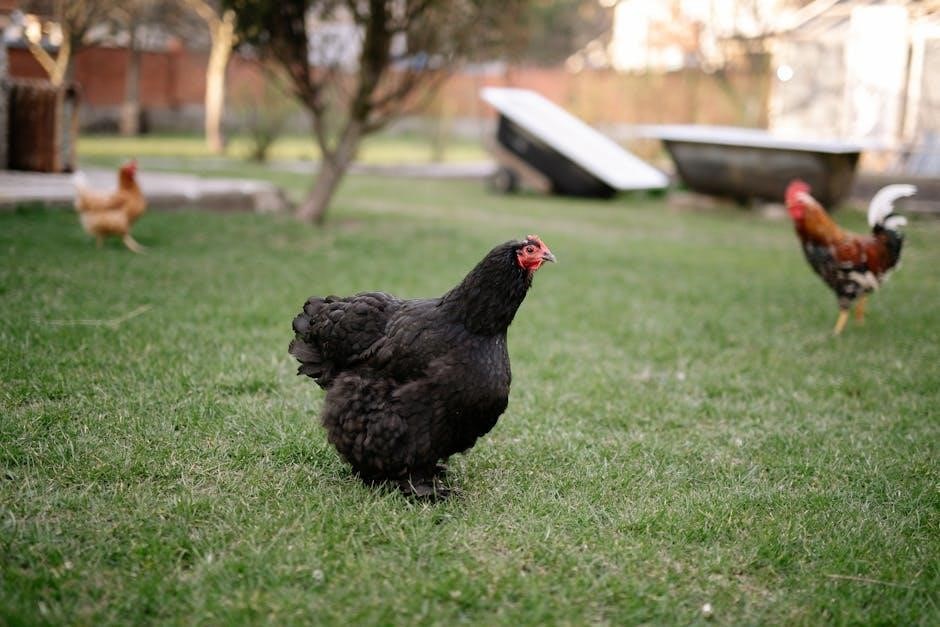
5.2. Comparison Charts (Size‚ Egg Production‚ Temperament)
The PDF includes detailed comparison charts to help users evaluate breeds based on size‚ egg production‚ and temperament. These charts provide a quick reference for understanding which breeds excel in specific areas‚ such as heavy egg-laying (Leghorns‚ Rhode Island Reds) or docile behavior (Orpingtons‚ Silkies). By comparing traits side by side‚ readers can make informed decisions about which breeds suit their needs‚ whether for eggs‚ meat‚ or companionship. This visual tool enhances the selection process for backyard flock owners and poultry enthusiasts alike.
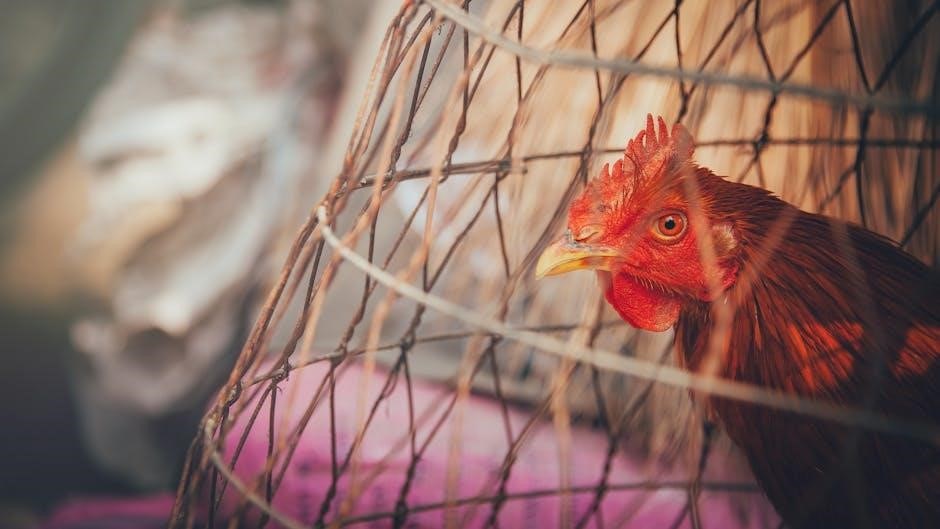
Heritage and Rare Breeds
This section highlights heritage and rare chicken breeds‚ focusing on their conservation status and unique characteristics. Breeds like the Ameraucana‚ Ancona‚ and Andalusian are showcased‚ emphasizing their historical significance and genetic diversity. The PDF underscores the importance of preserving these breeds‚ as they often possess traits that modern commercial breeds lack. Readers gain insight into the efforts to protect these rare varieties and their adaptability to various environments‚ making them valuable for sustainable poultry-keeping practices.
6.1. Conservation Status and Importance
Rare chicken breeds face threats from modern agriculture‚ making conservation vital. The PDF outlines the conservation status of heritage breeds‚ highlighting their genetic diversity. These breeds often exhibit unique traits beneficial for sustainable farming. Efforts to preserve them ensure a broader gene pool‚ protecting against disease and environmental challenges. Conservation programs and backyard keepers play a crucial role in safeguarding these breeds for future generations‚ maintaining biodiversity in poultry. Their survival is essential for agricultural resilience.
6.2. Unique Features of Rare Breeds
Rare chicken breeds often possess distinctive traits‚ such as unique feather patterns‚ egg colors‚ or temperaments. The PDF highlights breeds like the Araucana‚ known for blue eggs‚ and the Silkie‚ with its plush‚ fur-like feathers. These breeds showcase genetic diversity‚ offering characteristics not found in common varieties. Their unique features make them valuable for collectors and enthusiasts‚ preserving heritage genetics while adding aesthetic and functional variety to poultry-keeping. These traits emphasize the importance of rare breeds in maintaining biodiversity.
How to Choose the Right Breed
Selecting the right chicken breed involves considering climate‚ purpose‚ and available space. For egg production‚ breeds like Rhode Island Red or Leghorn are ideal‚ while Australorp or Plymouth Rock are great for dual-purpose use. If you prefer unique traits‚ Araucana or Silkie offer distinctive features. Assess your environment and goals to match with breeds that thrive in those conditions. The PDF guide provides detailed profiles to help you make an informed decision and find the perfect fit for your needs. This ensures a successful and rewarding poultry-keeping experience.
7.1. Consider Climate and Environment
When choosing a chicken breed‚ consider the local climate and environment. Breeds like Rhode Island Reds and Leghorns adapt well to various conditions‚ while Silkies prefer milder climates. Cold-hardy breeds such as Australorps and Orpingtons thrive in cooler regions‚ while Mediterranean breeds like Andalusians excel in warmer areas. Ensure the breed matches your region’s temperature extremes and humidity levels for optimal health and productivity. The PDF guide provides detailed climate suitability for each breed‚ helping you make the best choice for your specific environment. This ensures your flock will thrive naturally.
7.2. Purpose (Eggs‚ Meat‚ Show)
Choosing the right chicken breed depends on your purpose—whether for eggs‚ meat‚ or show. Breeds like Leghorns and Rhode Island Reds are ideal for egg production‚ laying hundreds of eggs annually. For meat‚ Cornish and Plymouth Rock are popular choices due to their fast growth and tender flesh. If you’re interested in show poultry‚ ornamental breeds like Orpingtons and Silkie Bantams are stunning and unique. The PDF guide helps you select the perfect breed based on your specific needs‚ ensuring productivity and satisfaction.
7.3. Space and Housing Requirements
Chicken breeds vary in space and housing needs. Larger breeds like Australorps and Orpingtons require more room‚ while smaller breeds such as Bantams are suitable for compact spaces. Aggressive breeds like Cubalaya need ample space to avoid conflicts. The PDF guide provides detailed recommendations for coop sizes‚ ensuring your flock stays healthy and happy. Proper housing is crucial for productivity and welfare‚ so choose a breed that fits your available space and resources.
Breeding and Genetics
Breeding chickens involves understanding genetic traits like egg color‚ size‚ and feather patterns. Cross-breeding can enhance desired characteristics‚ such as egg production or temperament. Genetic diversity ensures robust health and adaptability. The PDF guide explores how genetics shape breed-specific features and provides insights into heritage conservation. Understanding these principles helps breeders make informed decisions for sustainable poultry keeping.
8.1. Basics of Chicken Genetics
Chicken genetics determine traits like egg color‚ feather patterns‚ and size. Recessive and dominant genes influence these characteristics. Understanding genetic principles helps breeders predict offspring traits. The PDF guide explains how genetic diversity shapes breed uniqueness and ensures healthy flocks. This foundation is crucial for selective breeding programs aiming to enhance specific features.
8.2. Cross-Breeding for Desired Traits
Cross-breeding combines genetic traits from different chicken breeds to achieve desired characteristics‚ such as improved egg production or unique feather patterns. This method allows breeders to enhance specific features while maintaining genetic diversity. The PDF guide explores successful cross-breeding strategies‚ highlighting how traits like egg color‚ size‚ and flock productivity can be optimized. Understanding genetic compatibility ensures successful outcomes‚ making cross-breeding a valuable tool for modern poultry enthusiasts.
Resources for Further Reading
For deeper insights‚ explore recommended books like Storey’s Illustrated Guide to Poultry Breeds and online databases offering comprehensive breed details. Utilize tools like the chicken breed selector to narrow down ideal breeds based on specific needs. Additionally‚ access PDF guides and academic journals for advanced knowledge on genetics and breeding practices. These resources provide valuable information to enhance your understanding of chicken breeds and their unique characteristics‚ ensuring informed decisions for your poultry projects.
9.1. Recommended Books and Guides
For in-depth knowledge‚ consider Storey’s Illustrated Guide to Poultry Breeds‚ a comprehensive resource detailing over 300 breeds. Another excellent choice is LP Malinovskaya’s guide‚ which covers genetics and breeding approaches. These books provide detailed descriptions‚ high-quality images‚ and expert advice‚ making them essential for enthusiasts and researchers alike. They are available in PDF formats‚ offering convenient access to extensive information on chicken breeds and their unique characteristics.
9.2. Online Databases and Tools
Explore online databases like the Vavilov Journal of Genetics and Breeding for detailed breed information. Utilize tools designed to help you find the perfect chicken based on egg-laying ability‚ size‚ and temperament. Websites offering PDF guides and poultry breed lists‚ such as the Williamson County Poultry Skillathon‚ provide comprehensive resources. These platforms are invaluable for researchers and enthusiasts seeking accurate and visual breed identification.

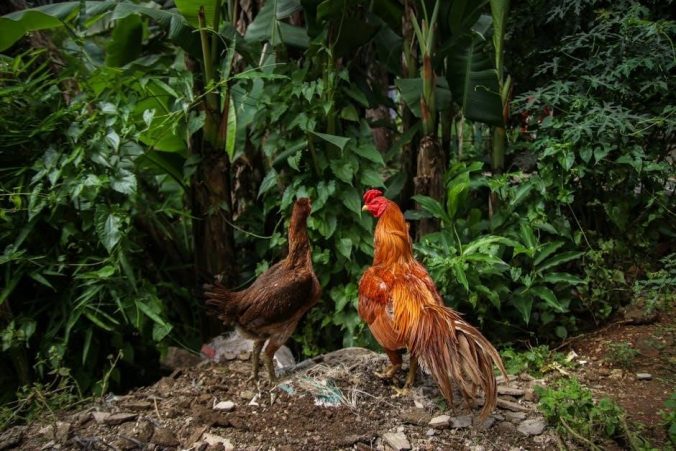
Leave a Reply
You must be logged in to post a comment.